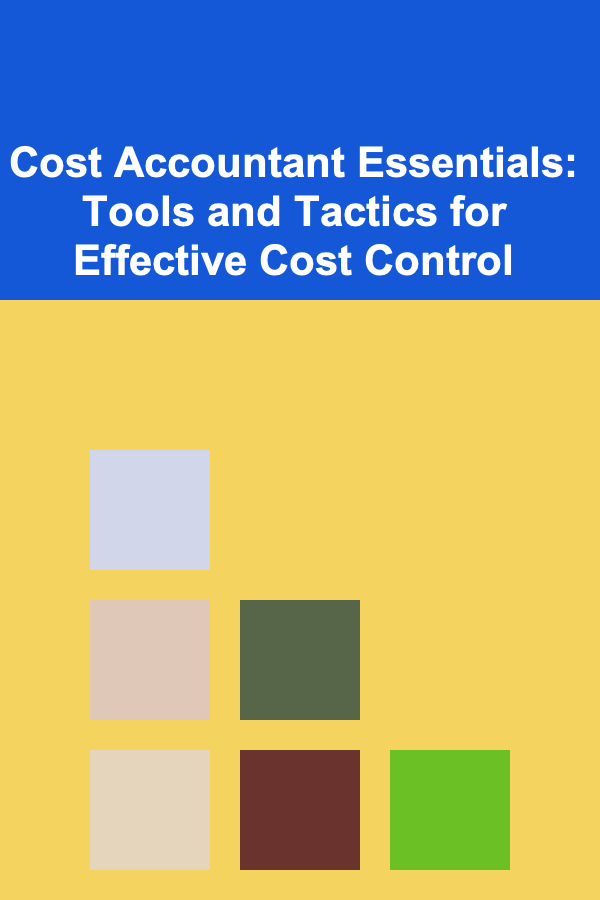
Cost Accountant Essentials: Tools and Tactics for Effective Cost Control
ebook include PDF & Audio bundle (Micro Guide)
$12.99$9.99
Limited Time Offer! Order within the next:

Cost accounting is a crucial discipline within the field of accounting that focuses on determining and analyzing the costs associated with the production of goods and services. By managing costs effectively, businesses can enhance profitability, improve financial decision-making, and optimize resource allocation. Whether you're a cost accountant or a business leader seeking to better understand cost control, mastering the essential tools and tactics of cost accounting can significantly contribute to the long-term success of your organization.
In this guide, we'll explore the tools and strategies that form the backbone of effective cost control. We'll also delve into how these practices can be implemented to drive actionable insights and cost-saving initiatives.
Understanding Cost Accounting
Before diving into the tools and tactics, it's essential to have a solid understanding of what cost accounting entails. Cost accounting is the practice of recording, classifying, and analyzing costs in order to help managers make informed financial decisions. It provides a granular view of expenses associated with manufacturing, operations, and other business activities.
The goal of cost accounting is to allocate costs accurately to the products, services, or departments that incur them, enabling businesses to track their financial health and make strategic decisions based on detailed financial data.
Key Concepts in Cost Accounting:
- Fixed Costs: Costs that remain constant regardless of production or sales volume (e.g., rent, salaries).
- Variable Costs: Costs that fluctuate in direct proportion to production levels (e.g., raw materials, labor).
- Direct Costs: Costs that can be directly attributed to the production of goods or services (e.g., direct labor, raw materials).
- Indirect Costs: Costs that cannot be directly attributed to a specific product but are necessary for overall operations (e.g., utilities, administrative expenses).
- Cost Allocation: The process of assigning indirect costs to specific products, services, or departments.
- Break-even Analysis: A method used to determine the point at which total revenues equal total costs, resulting in no profit or loss.
Key Tools for Effective Cost Control
A range of tools are available to cost accountants to help track, control, and manage costs. These tools provide the data and insights necessary to analyze cost structures, identify inefficiencies, and improve profitability. Some of the most important tools in cost accounting include:
1. Cost Accounting Software
The use of specialized software simplifies many aspects of cost accounting, allowing for accurate cost allocation and real-time financial tracking. Cost accounting software can automate various accounting functions, such as inventory management, job costing, and variance analysis.
- Features to Look For :
- Job Costing: Track the costs associated with individual projects or products, including labor, materials, and overhead.
- Standard Costing: Compare actual costs with predetermined or standard costs, helping identify variances and inefficiencies.
- Activity-Based Costing (ABC): Allocate costs based on the activities that drive costs, offering a more precise allocation method for indirect costs.
- Real-Time Reporting: Generate up-to-the-minute reports on expenses, revenues, and profitability, allowing for quick adjustments to operations.
Some widely used cost accounting software includes QuickBooks, SAP, and Xero. Implementing such software can improve accuracy, speed, and transparency in cost management.
2. Standard Costing
Standard costing is a system where predetermined or "standard" costs are established for various cost elements, such as direct labor, direct materials, and overhead. By comparing actual costs with these standards, cost accountants can easily identify variances and take corrective actions when necessary.
-
How Standard Costing Works:
- Establish standard costs for direct materials, labor, and overhead based on historical data, industry benchmarks, or market conditions.
- Periodically compare actual costs to these standards and calculate variances.
- Variances can be either favorable (actual costs lower than standard) or unfavorable (actual costs higher than standard).
-
Benefits:
- Helps pinpoint inefficiencies in the production process.
- Provides a benchmark for performance and cost control.
- Facilitates budgeting and financial planning.
3. Activity-Based Costing (ABC)
Activity-Based Costing (ABC) is a more sophisticated method of allocating indirect costs based on the activities that drive them. Unlike traditional costing systems that allocate overhead evenly, ABC assigns costs based on the actual activities and resources used by each product or service.
-
How ABC Works:
- Identify key activities in the business (e.g., machine setup, order processing).
- Assign costs to each activity based on resource consumption.
- Allocate costs to products or services based on their use of these activities.
-
Benefits:
- More accurate cost allocation, especially in complex operations with diverse products or services.
- Helps identify high-cost activities that can be streamlined or eliminated.
- Supports strategic decision-making by providing a clearer picture of true product or service costs.
4. Job Order Costing
Job Order Costing is used when products or services are produced based on specific customer orders. Each job or order is treated as a unique cost object, and costs are tracked separately for each job.
-
How Job Order Costing Works:
- Track direct materials, direct labor, and overhead costs for each job.
- Maintain a job cost sheet to record costs associated with each specific order.
- At completion, the total cost of the job is calculated and compared to the revenue to assess profitability.
-
Benefits:
- Provides detailed cost information for each order, which helps in setting prices.
- Essential for businesses that produce customized goods or services.
- Facilitates more accurate cost control by tracking costs at the individual job level.
5. Marginal Costing
Marginal costing focuses on analyzing the additional cost incurred when producing one more unit of a product. It is a useful tool for short-term decision-making, particularly when deciding whether to accept a special order, adjust production levels, or evaluate the impact of cost changes.
-
How Marginal Costing Works:
- Calculate the additional variable costs associated with producing one extra unit.
- Consider fixed costs separately, as they do not change with the level of production.
-
Benefits:
- Aids in pricing decisions by helping businesses understand the cost structure at different levels of production.
- Useful for cost control in scenarios where production volume can be adjusted quickly.
Tactics for Effective Cost Control
Implementing cost control tactics effectively requires a combination of strategic decision-making, monitoring, and proactive management. Below are several proven tactics that cost accountants can employ to drive cost-saving initiatives and maximize profitability:
1. Budgeting and Forecasting
Budgets are essential tools for cost control. By creating detailed budgets that align with business goals, accountants can ensure that costs are kept within acceptable limits. Regular forecasting allows companies to anticipate fluctuations in costs and revenues, helping them make informed decisions.
- Tactics :
- Develop a zero-based budget, where every expense must be justified, rather than assuming past budgets.
- Regularly review and adjust budgets based on changing business conditions.
- Use historical data to predict future expenses and revenue trends.
2. Cost Variance Analysis
Variance analysis is a technique used to identify the differences between planned costs and actual costs. This can help businesses identify areas where costs are out of line and prompt corrective actions.
- Tactics :
- Perform a detailed variance analysis for both fixed and variable costs.
- Investigate the causes of major variances, such as inefficient production methods, price increases, or excess labor costs.
- Take corrective actions such as renegotiating supplier contracts, improving production efficiency, or reducing waste.
3. Process Optimization
Optimizing internal processes is a critical tactic for cost control. By identifying bottlenecks, inefficiencies, and unnecessary activities, businesses can streamline operations and reduce costs.
- Tactics :
- Map out business processes to identify areas of inefficiency.
- Invest in automation and technology to reduce manual labor and eliminate errors.
- Adopt lean manufacturing principles to eliminate waste and improve productivity.
4. Vendor and Supplier Management
Negotiating favorable contracts with vendors and suppliers can have a significant impact on cost control. By regularly evaluating supplier performance, businesses can ensure they are getting the best value for their money.
- Tactics :
- Regularly review supplier contracts and renegotiate terms to achieve cost savings.
- Consolidate purchases to take advantage of bulk discounts.
- Source alternative suppliers to increase competition and reduce prices.
5. Employee Training and Development
Employees are often the frontline in identifying and addressing cost-saving opportunities. By investing in ongoing training and promoting a culture of cost consciousness, companies can improve cost management at all levels.
- Tactics :
- Train employees on cost-saving practices and how their actions impact the bottom line.
- Foster an environment where employees are encouraged to suggest cost-saving initiatives.
- Align employee incentives with cost-control objectives to encourage participation.
Conclusion
Effective cost control is essential for any business looking to thrive in an increasingly competitive environment. By leveraging the right tools, such as cost accounting software, standard costing, and activity-based costing, and implementing tactical strategies such as variance analysis, budgeting, and process optimization, cost accountants can help their organizations manage costs effectively and improve profitability.
Cost control is not just about cutting costs---it's about making informed decisions that will lead to sustainable growth. By applying these tools and tactics, cost accountants can empower businesses to take charge of their financial health, foster continuous improvement, and achieve long-term success.
Reading More From Our Other Websites
- [Home Pet Care 101] How to Maintain a Pet-Friendly Home During the Holidays
- [Home Staging 101] How to Avoid Common Home Staging Mistakes
- [Personal Care Tips 101] How to Choose a Perfume for Your First Date
- [Hiking with Kids Tip 101] Best Strategies for Managing Hiking Gear Weight When Trekking with a Baby Carrier
- [Organization Tip 101] How to Create a Smartphone App System for Home Tasks
- [Personal Care Tips 101] How to Get the Best Shaving Cream Lather for an Effortless Shave
- [Organization Tip 101] How to Organize Specialty Cooking Tools for Quick Access
- [Home Space Saving 101] How to Create a Functional Entryway in Limited Space
- [Personal Investment 101] How to Understand and Use Investment Risk Tolerance
- [Home Holiday Decoration 101] How to Create a Cozy, Hygge-Inspired Holiday Decor

How to Choose the Best Pet Insurance for Your Furry Friend
Read More
How to Create a Functional Lighting Scheme for Your Home's Hallways
Read More
How To Hike in Rainy Conditions: Gear and Tips
Read MoreHow to Make a Checklist for Tracking Job Applications
Read More
How to Make a Crisis Management Checklist for Recovery and Aftermath
Read More
How to Arrange Flowers for a Sympathy Tribute
Read MoreOther Products

How to Choose the Best Pet Insurance for Your Furry Friend
Read More
How to Create a Functional Lighting Scheme for Your Home's Hallways
Read More
How To Hike in Rainy Conditions: Gear and Tips
Read MoreHow to Make a Checklist for Tracking Job Applications
Read More
How to Make a Crisis Management Checklist for Recovery and Aftermath
Read More